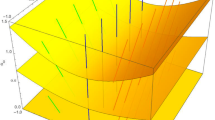Summary
Weyl’s (1929) geometrical theory of gauge (phase) transformations for fermions and the electromagnetic field is generalized so as to apply to bosons as well. This is done by introducingcomplex base vectors. The resulting theory is closely related to the Einstein-Schrödinger theory in its Hermitian form, and enables one to identify the electromagnetic field tensor. Two physical consequences are deduced from the theory:a) The charges of all bosons are integer multiples of a basic charge,b) The direct interaction between a particle and the electromagnetic field is invariant under space reflexions and time reflexions. A theoretical criterion is suggested (based on the argument leading tob) for determining which interactions are parity conserving.
Riassunto
Si generalizza la teoria geometrica di Weyl (1929) delle trasformazioni di gauge (fase) per fermioni e per il oampo elettromagnetico in modo da renderla applicabile anche ai bosoni. Ciò si ottiene introducendo vettoricomplessi. La teoria che ne risulta è strettamente connessa alla teoria di Einstein-Schrödinger nella sua forma hermitiana e permette di identifleare il tensore elettromagnetico. Dalla teoria si deducono due conseguenze flsiche:a) le cariche di tutti i bosoni sono multipli interi di una carica base; 6) l’interazione diretta tra una particella e il campo elettromagnetico è invariante per le riflessioni dello spazio e del tempo. Si propone un criterio teorico (basato su un argomento che conduce a b)) per determinare quali interazioni conservino la parità.
Similar content being viewed by others
References
Phys. Rev.,107, 632 (1957).
The need for such a result has been emphasized byP. A. M. Dirac:Phys. Rev.,74, 817 (1948), andE. P. Wigner:Proc. Amer. Phil. Soc,93, 521 (1949), for both bosoris and fremions.
T. D. Lee andC. N. Yang:Phys. Rev.,104, 254 (1956).
H. Weyl:Proc. Nat. Acad. Sci.,15, 323 (1929);Zeits. f. Phys.,56, 330 (1929);Phys. Rev.,77, 699 (1950).
H. Weyl:Space-Time-Matter (New York, 1951), p. 282.
V. Fock:Zeits. f. Phys.,57, 261 (1929);E. Schrödinger:Berl. Ber., 105 (1932);L. Infeld andB. L. v. dee Waerden:Berl. Ber., 380 (1933);W. L. Bade andH. Jehle:Rev. Mod. Phys.,25, 714 (1953);P. G. Bergmann:Phys. Rev.,107, 624 (1957).
W. Pauli:Rev. Mod. Phys.,13, 203 (1941).
Cf.H. Weyl:Proc. Nat. Acad. Sci.,15, 323 (1929), bottom of p. 329.
A. Einstein:Rev. Mod. Phys.,20, 35 (1948).
E. Schbödinger:Space-Time Structure (Cambridge, 1950).
M.-A. Tonnelat:La Théorie du Champ Unifié d’Einstein (Paris, 1955).
L. P. Eisenhart:Riemannian Geometry (Princeton, 1926), Chap. III.
F. D. Murnaghan:The Theory of Group Representations (Baltimore, 1938), p. 352.
L. Rosenfeld:Acad. Roy. Belg.,18, No. 6 (1940).
R. Brauer andH. Weyl:Am. Journ. Math.,57, 425 (1935);W. Pauli:Ann. Inst. E. Poinearé,6, 109 (1936).
E. M. Corson:Introduction to Tensors, Spinors and Relativistic Wave Equations (London, 1953), p. 40.
J. Callaway:Phys. Rev.,92, 1567 (1953);W. B. Bonnor:Ann. Inst. H. Poincaré,15, 133 (1957).
D. W. Sciama:Proc. Camb. Phil. Soc,54, 72 (1958); cf. alsoO. Costa de, Beauregard:Journ. de Math.,22, 85 (1943) especially footnote 1 on p. 129.
G. Wentzel:Quantum Theory of Fields (New York, 1949), p. 60.
PI. Weyl:The Classical Groups (Princeton, 1946), p. 194.
C. S. Wu, E. Ambler, K. W. Hayward, D. D. Hoppes andR. P. Hudson:Phys. Rev.,105, 1413 (1957);R. L. G-arwin, L. M. Lederman andM. Weinrich:Phys. Rev.,105, 1415 (1957);J. I. Friedman andV. L. Telegdi:Phys. Rev.,105, 1681 (1957).
Cf.P. A. M. Dirac:Rev. Mod. Phys.,21, 392 (1949);J. M. Jauch andF. Rohrlich:The Theory of Photons and Electrons (Cambridge, Mass., 1955), p. 86.
Author information
Authors and Affiliations
Rights and permissions
About this article
Cite this article
Sciama, D.W. On a geometrical theory of the electromagnetic field. Nuovo Cim 8, 417–431 (1958). https://doi.org/10.1007/BF02828748
Received:
Published:
Issue Date:
DOI: https://doi.org/10.1007/BF02828748




